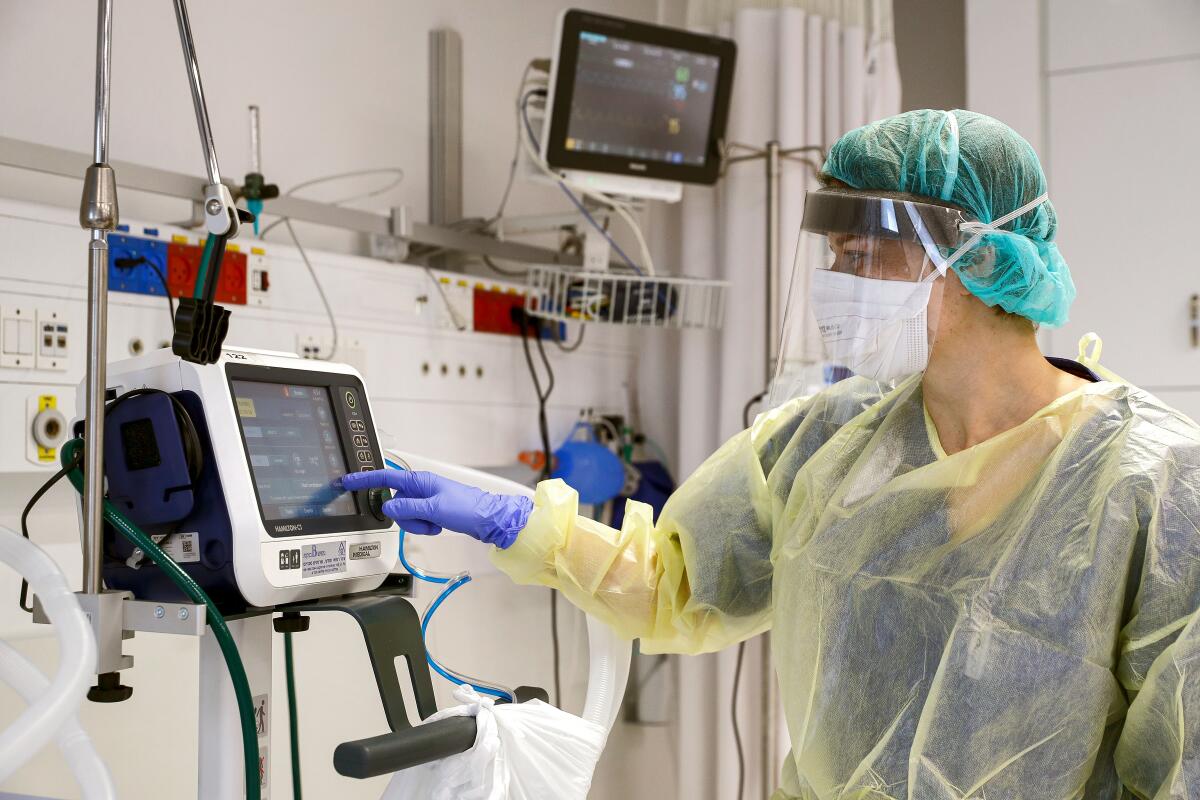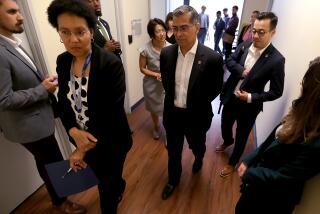A disaster foretold: Shortages of ventilators and other medical supplies have long been warned about

- Share via
WASHINGTON — Fear was growing in hospitals across the country in 2009 as a frightening epidemic that came to be called the H1N1 swine flu swept across the globe.
From Galveston, Texas, where a hospital ran out of test kits, to Loma Linda University Medical Center in San Bernardino, which had to set up tents to handle a crush of patients, to New York, where hospitals scrambled to bring on extra emergency staff, it appeared the nation’s healthcare system would be overwhelmed.
The worst did not materialize. The lesson, though, was clear: The nation needed larger caches of standby medical supplies and hospitals that were better prepared to handle a surge of infected patients.
A decade later, the coronavirus crisis is exposing many of the same gaps. Inadequate supplies of protective masks, ventilators, intensive care beds and other medical resources are forcing mass closures of schools and businesses and restrictions on everyday activities as public officials rush to slow the virus so America’s medical system isn’t overwhelmed.
“So much that was predicted has come to pass,” said Marcia Crosse, former head of the healthcare section of the Government Accountability Office. Since the early 2000s, the GAO, the federal government’s leading internal watchdog, has issued a steady stream of reports about poor pandemic planning.
As the current crisis has widened, President Trump has attempted to deflect responsibility for his administration’s poor planning, suggesting the coronavirus outbreak was inconceivable.
“Nobody knew there would be a pandemic or epidemic of this proportion,” the president said Thursday.
The opposite is true. The GAO, public health experts and others issued a steady drumbeat of warnings that America would sooner or later face a widespread infectious disease outbreak or a major bioterrorism attack and was woefully unprepared.
In both 2018 and 2019, U.S. intelligence agencies issued insistent warnings in their annual Worldwide Threat Assessment.
“We assess that the United States and the world will remain vulnerable to the next flu pandemic or large-scale outbreak of a contagious disease that could lead to massive rates of death and disability, severely affect the world economy, strain international resources, and increase calls on the United States for support,” the 2019 report noted.
That is only the most recent warning. As early as 2003, the GAO cautioned that many urban hospitals lacked enough ventilators to treat a large number of patients suffering from respiratory problems that would be expected in an anthrax or botulism outbreak.
“Ventilators have long been recognized as a weak link,” said Crosse, who spent 35 years at GAO before retiring in 2018.
Today, a lack of ventilators is emerging as a potentially critical shortfall because patients hit hardest by COVID-19, the illness caused by the coronavirus, often suffer severe respiratory problems.
Federal policymakers concentrated heavily on pandemic preparedness in the aftermath of the 9/11 terrorist attacks and anthrax scare in 2001, which both exposed gaps in the nation’s emergency response system.
In 2005, the administration of President George W. Bush published a landmark “National Strategy for Pandemic Influenza.” The document, among other things, highlighted the need for plans to distribute necessary medical supplies from the nation’s Strategic National Stockpile and to support state and local efforts to “surge” medical personnel and facilities to handle an outbreak.
Medical equipment such as masks and protective clothing in particular were given high priority as planners recognized that doctors, nurses and other medical staff were most vulnerable.
After the swine flu epidemic in 2009, a safety-equipment industry association and a federally sponsored task force both recommended that depleted supplies of N95 respirator masks, which filter out airborne particles, be replenished by the stockpile, which is maintained by the U.S. Department of Health and Human Services.
That didn’t happen, according to Charles Johnson, president of the International Safety Equipment Assn.
The stockpile drew down about 100 million masks during the 2009 epidemic, Johnson said.
“Our association is unaware of any major effort to restore the stockpile to cover that drawdown,” he said.
Last month, Health and Human Services Secretary Alex Azar said that available supplies included just 12 million N95 masks and 30 million surgical masks, a tiny fraction of the 3.5 billion masks one of Azar’s deputies later testified the nation’s healthcare system would need.
Already across the country, there are signs of medical centers running out of protective equipment, compounding the challenges caused by the federal government’s inadequate supply of coronavirus testing kits.
At Sinai Health System, which serves largely low-income patients on Chicago’s South and Southwest sides, hospital officials started signing out masks and other protective equipment as carefully as they handle narcotics.
“We’ve never had to do that before,” said Karen Teitelbaum, the system’s chief executive.
These shortages are particularly appalling, said Jeffrey Levi, a professor at the Milken Institute School of Public Health at George Washington University and former head of the Trust for America’s Health, a nonprofit public health advocacy group.
“Every time we have an emergency, protecting healthcare workers has been the No. 1 policy issue,” Levi said. “To have neglected that is shocking.”
Making the case for investments in material and hospital planning has long been challenging as most people have difficulty envisioning a major disaster, acknowledged Dr. Eric Toner of Johns Hopkins University, an authority on pandemic preparedness.
Hospitals also are under pressure to keep margins thin and eliminate spending on staff and supplies that aren’t used all the time.
The budget crunch represents a particular challenge for so-called safety-net hospitals, institutions that serve many uninsured patients and those covered by Medicaid, and consequently collect less revenue. These same hospitals are now expecting a large surge in coronavirus patients but have limited resources to ramp up staffing and add intensive care beds if needed.
“Cash is very limited,” said Charlie Shields, chief executive of Truman Medical Centers in Kansas City. Shields said the finances are under even more stress since the hospital canceled elective procedures and shut down its dental services to prepare for the pandemic, moves that reduce hospital revenue.
Toner at Johns Hopkins noted these kinds of strains are why the federal government should have provided a stronger backstop.
“The argument we’ve made for 20 years is that if we want to have prepared healthcare institutions, this has to be a societal responsibility, and that means a government responsibility.”
After 9/11, the federal Hospital Preparedness Program was created in 2002 to help hospitals plan for public health emergencies and terrorist attacks.
But as time passed, the program was steadily cut. In 2007, Congress trimmed $44 million from the program’s budget. In 2014, lawmakers cut $120 million.
Overall, money for the program has been slashed by about half since 2003, said John Auerbach, chief executive of the Trust for America’s Health.
Auerbach, who was Boston health commissioner for nine years, said he and other public health officials routinely pleaded with Congress to restore the spending.
He said lawmakers frequently offered the same response: “Do we still need that?”
More to Read
Get the L.A. Times Politics newsletter
Deeply reported insights into legislation, politics and policy from Sacramento, Washington and beyond. In your inbox three times per week.
You may occasionally receive promotional content from the Los Angeles Times.













